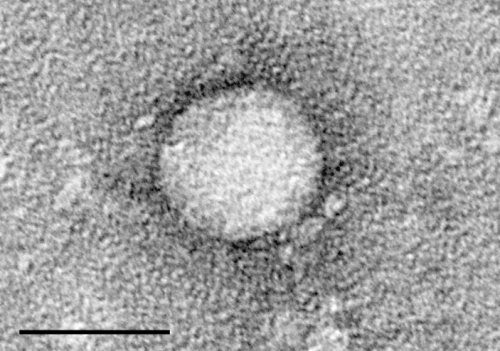Hepatitis C virus uses Netrin-1 to hijack host cells

Hepatitis C virus (HCV) is a small, enveloped virus comprising an RNA genome encased in a protein capsid and surrounded by a lipid bilayer containing two glycoproteins. Acute infection can cause hepatitis but the virus usually persists as a chronic infection of the liver where it can cause inflammation and, eventually, hepatocellular carcinoma. How HCV subverts hepatocytes to turn them into virus-producing factories, has remained unclear.
In a paper publishing in the Open Access journal PLOS Biology on 31st March, a research team based in Lyon (France) finds a small secreted protein, Netrin-1, closely implicated in the lifecycle of this virus. Romain Parent and his collaborators report that HCV enhances expression of Netrin-1 in hepatocytes and, in turn, Netrin-1 increases both the amount of the viral RNA genome and the infectivity of the virus particles produced. What's more, the authors present evidence that Netrin-1 also promotes viral uptake into uninfected cells, perhaps by blocking internalisation of the epidermal growth factor receptor (EGFR) and so increasing the amount of this cofactor for viral uptake on the cell surface.
HCV replicates mainly in the hepatocytes of the liver. It enters these cells by complex interactions with several cell surface proteins and, once inside, replicates on intracellular membranes, in particular those of the endoplasmic reticulum (ER). These authors were drawn to study the possible role of Netrin-1 in HCV infection because of previous studies showing its involvement in several cancer types as well as in inflammatory diseases associated with cancer.
The researchers first looked at the amount of Netrin-1 mRNA in liver biopsy samples from patients with HCV and compared this to similar samples from virus-free patients. They saw a substantial (23-fold) increase in the amount of Netrin-1 mRNA in the infected samples, which was reversed by treatment of the patients with antiviral drugs. Likewise, HCV infection of primary human hepatocytes and a hepatocyte cell line in culture resulted in a large increase in the amount of Netrin-1 mRNA in the cells and newly translated Netrin-1 protein.
Netrin-1 mRNA is known to bind to the La-related protein LARP1, although the functional significance of this interaction is unclear. These researchers found that LARP1 also interacts specifically with one of the non-structural HCV proteins, NS5A, on ER membranes where it promotes translation of Netrin-1. Moreover, Netrin-1 levels correlate directly with the amount of HCV RNA produced in infected cells and with the infectivity of the virus particles produced in overexpression and knockdown studies, perhaps by binding directly to the HCV particles. Thus, the authors concluded that HCV infection promotes Netrin-1 production and, in turn, Netrin-1 promotes HCV production.
But this is not the only influence of Netrin-1 on the HCV lifecycle. The authors also report evidence that Netrin-1 expression increases the level of EGFR protein at the cell surface—and the level of activated (phosphorylated) EGFR - by impeding its internalisation, and this seems to promote virus entry into the cells.
This positive feedback loop suggests how HCV converts hepatocytes into viral factories, but it doesn't explain how the virus limits infection and cell death to persist for years in liver cells. Netrin-1 might hold a clue to this too as it is an inhibitory ligand of the UNC5 family of so-called 'dependence receptors', which auto-activate and trigger apoptosis. So, enhanced amounts of secreted Netrin-1 might help to prevent the death of infected liver cells. Netrin-1 expression did not confer a pro-survival advantage to the cultured cells used in this study, but, as quoted by the authors, "Netrin-1-associated cell survival in the liver has been meanwhile observed by the same team during the unfolded protein response, a hallmark of chronic liver disease, in animals (Cell Mol Gastroenterol Hepatol 2016, in press). Given the frequency of dysregulation of the EGFR pathway in late stage chronic liver disease, this functional association between Netrin-1 and EGFR is of potential relevance in the onset of hepatocellular carcinoma too".
More information: Plissonnier M-L, Lahlali T, Michelet M, Lebossé F, Cottarel J, Beer M, et al. (2016) Epidermal Growth Factor Receptor-Dependent Mutual Amplification between Netrin-1 and the Hepatitis C Virus. PLoS Biol 14(3): e1002421. DOI: 10.1371/journal.pbio.1002421


















